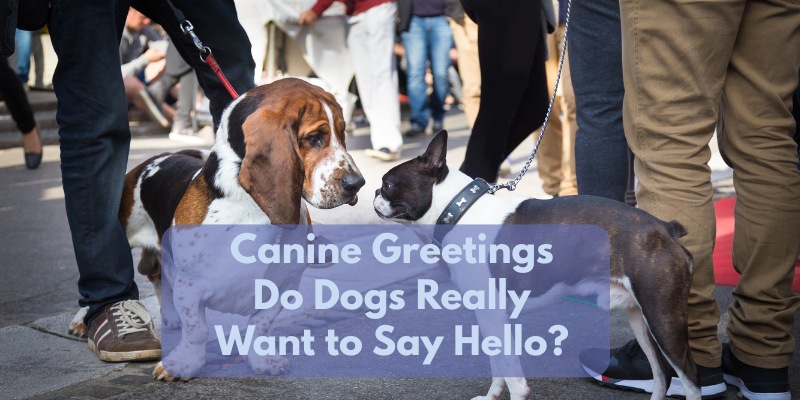Do Dogs Really Want to Say Hello? The Pros and Cons of On-Leash Greetings
- Victoria Cherpes

- May 13
- 3 min read

When taking a stroll with your dog, you may feel compelled to stop and allow an on-leash greeting whenever another dog-owner pair crosses your path. But have you wondered if your dog truly benefits from these interactions? Or are we projecting human constructs of politeness onto their behavior? This blog dives into the benefits and risks of on-leash greetings and explores whether dogs are as eager to say "hello" as we assume.
The Nature of Dog Greetings
Dog greetings are deeply rooted in their olfactory communication. When dogs meet, they typically engage in sniffing each other’s anogenital areas, faces, or inguinal regions. These short exchanges, often lasting just seconds, help dogs gather critical information about each other, such as gender, mood, social ranking, and health status. However, not all greetings are beneficial, especially when they occur on-leash.
Benefits of On-Leash Dog Greetings
1. Controlled Socialization
On-leash greetings provide dogs with an opportunity to meet others in a controlled setting. This can facilitate exposure to other dogs, which is especially beneficial for puppies learning proper social skills or for dogs working through behavioral rehabilitation programs.
2. Bonding Opportunity
For dogs that enjoy meeting others, a brief on-leash greeting can serve as a positive and mentally stimulating experience, offering enrichment on their daily walks.
3. Information Gathering
From an evolutionary perspective, dogs use these greetings to gather information about the individuals they encounter. If done correctly, this process can help reduce fear or anxiety related to unfamiliar dogs.
Risks of On-Leash Greetings
1. Increased Threat Perception
Research shows that dogs on a leash perceive potential threats more acutely. According to a study by Rezac et al. (2011), threats are twice as likely during on-leash greetings compared to off-leash interactions. The restrictive nature of the leash prevents dogs from effectively using body language to signal trust or discomfort, which can escalate tensions.
2. Limited Escape Options
Leashes limit a dog’s natural ability to physically move away from stressful situations. When a dog cannot retreat, they may feel trapped, resulting in reactive behaviors such as barking, lunging, or even biting to defend themselves.
3. Mismatched Signals
Running into unfamiliar dogs can lead to unreciprocated greetings where one dog tries to interact while the other avoids engagement. Ward’s (2020) study on off-leash behavior found that unreciprocated greetings often happen when there's a significant size mismatch or when one dog assumes a higher body posture that signals dominance, potentially causing fear in the other dog.
4. Prolonged Close Proximity
Unlike off-leash meetings where dogs can conduct quick interactions, on-leash greetings often force dogs into prolonged contact due to their owners chatting. This extended proximity can lead to discomfort or result in heightened stress for one or both dogs involved.
Alternatives to On-Leash Greetings
If you’re unsure whether to allow your dog to greet others while on a leash, consider these alternatives:
Practice parallel walks: Walking in the same direction, but at a comfortable distance, helps dogs adjust to each other’s presence without direct interaction.
Choose off-leash settings: Dog parks or secure areas allow dogs to meet naturally and disengage when needed, reducing the risk of conflict.
Observe body language: If your dog shows signs of discomfort (low body posture, tucked tail, or avoidance), skip the greeting altogether. Respecting your dog's boundaries is key to building trust and confidence.
Do Dogs Truly Want to Say Hello?
Not always. Dogs are individuals, just like humans, and their preference for greetings depends on several factors, including personality, prior experiences, and the context of the interaction. Research shows that not all dogs seek out greetings or lengthy social interactions. For many, short sniffing sessions suffice to gather the necessary information before moving on.
What does this mean for dog owners? Rather than assuming every encounter must result in a greeting, it’s vital to assess the situation and your dog’s comfort level before initiating any interaction.
Final Thoughts
While the idea of letting your dog "say hello" on every walk might feel courteous, it’s critical to focus on your dog’s well-being. Understanding canine behavior and using alternative approaches when needed can reduce stress and foster safer, healthier experiences for both your dog and others.
If you’re still unsure about navigating dog-to-dog interactions, consult a professional dog trainer or behaviorist for personalized advice. Ultimately, prioritizing your dog’s comfort will lead to more joyful and stress-free walks for both of you.





Comments